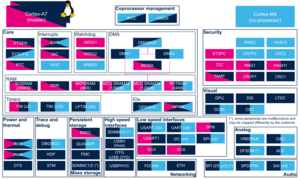Registered User mNo edit summary |
Registered User mNo edit summary |
||
| Line 1: | Line 1: | ||
==Article purpose== | ==Article purpose== | ||
The purpose of this article is to | The purpose of this article is to | ||
| Line 6: | Line 5: | ||
* explain how each instance can be allocated to the three runtime contexts and linked to the corresponding software components | * explain how each instance can be allocated to the three runtime contexts and linked to the corresponding software components | ||
* explain how to configure the LPTIM peripheral | * explain how to configure the LPTIM peripheral | ||
==Peripheral overview== | ==Peripheral overview== | ||
| Line 30: | Line 27: | ||
====Overview==== | ====Overview==== | ||
LPTIM instances can be allocated to: | LPTIM instances can be allocated to: | ||
*the Arm<sup>®</sup> Cortex<sup>®</sup>-A7 non-secure to be used under Linux<sup>®</sup> with [[PWM overview|PWM]] | *the Arm<sup>®</sup> Cortex<sup>®</sup>-A7 non-secure to be used under Linux<sup>®</sup> with [[PWM overview|PWM]], [[IIO overview|IIO]], ''Counter'' or/and ''Clock events'' frameworks, | ||
or | or | ||
* the Arm<sup>®</sup> Cortex<sup>®</sup>-M4 to be used with STM32Cube MPU Package with [[STM32CubeMP1 architecture|LPTIM HAL driver]] | * the Arm<sup>®</sup> Cortex<sup>®</sup>-M4 to be used with STM32Cube MPU Package with [[STM32CubeMP1 architecture|LPTIM HAL driver]] | ||
| Line 39: | Line 36: | ||
| [[LPTIM internal peripheral|LPTIM]] | | [[LPTIM internal peripheral|LPTIM]] | ||
| | | | ||
| [[PWM overview| | | [[PWM overview|PWM framework]],<br>[[IIO overview|IIO framework]],<br>''Counter'' framework,<br>''Clock events'' framework | ||
| [[STM32CubeMP1 architecture|STM32Cube LPTIM driver]] | | [[STM32CubeMP1 architecture|STM32Cube LPTIM driver]] | ||
| | | | ||
Latest revision as of 10:57, 29 March 2021
1. Article purpose
The purpose of this article is to
- briefly introduce the LPTIM peripheral and its main features
- indicate the level of security supported by this hardware block
- explain how each instance can be allocated to the three runtime contexts and linked to the corresponding software components
- explain how to configure the LPTIM peripheral
2. Peripheral overview
The LPTIM peripheral is a single channel low-power timer unit, that can continue to run even during low power modes when it selects a clock source that remains active in RCC.
2.1. Features
Refer to STM32MP15 reference manuals for the complete list of features, and to the software components, introduced below, to know which features are really implemented.
The LPTIM peripheral is available in different configurations, depending on the selected instance :
- LPTIM1 and LPTIM2 can act as PWM, quadrature encoder[1], external event counter, trigger source for other internal peripherals like: ADC[2], DAC[3], DFSDM[4].
- LPTIM3 can act as PWM, external event counter, trigger source for other internal peripherals like ADC[2], DFSDM[4].
- LPTIM4 and LPTIM5 can act as PWM.
2.2. Security support
The LPTIM is a non-secure peripheral.
3. Peripheral usage and associated software
3.1. Boot time
The LPTIM is not used at boot time.
3.2. Runtime
3.2.1. Overview
LPTIM instances can be allocated to:
- the Arm® Cortex®-A7 non-secure to be used under Linux® with PWM, IIO, Counter or/and Clock events frameworks,
or
- the Arm® Cortex®-M4 to be used with STM32Cube MPU Package with LPTIM HAL driver
3.2.2. Software frameworks
| Domain | Peripheral | Software frameworks | Comment | ||
|---|---|---|---|---|---|
| Cortex-A7 secure (OP-TEE) |
Cortex-A7 non-secure (Linux) |
Cortex-M4 (STM32Cube) | |||
| Core/Timers | LPTIM | PWM framework, IIO framework, Counter framework, Clock events framework |
STM32Cube LPTIM driver | ||
3.2.3. Peripheral configuration
The configuration is applied by the firmware running in the context to which the peripheral is assigned. The configuration by itself can be performed via STM32CubeMX tool for all internal peripherals. It can then be manually completed (especially for external peripherals) according to the information given in the corresponding software framework article.
For Linux kernel configuration, please refer to LPTIM device tree configuration and STM32 LPTIM Linux driver articles.
3.2.4. Peripheral assignment
Check boxes illustrate the possible peripheral allocations supported by STM32 MPU Embedded Software:
- ☐ means that the peripheral can be assigned (☑) to the given runtime context.
- ✓ is used for system peripherals that cannot be unchecked because they are statically connected in the device.
Refer to How to assign an internal peripheral to a runtime context for more information on how to assign peripherals manually or via STM32CubeMX.
The present chapter describes STMicroelectronics recommendations or choice of implementation. Additional possiblities might be described in STM32MP15 reference manuals.
| Domain | Peripheral | Runtime allocation | Comment | |||
|---|---|---|---|---|---|---|
| Instance | Cortex-A7 secure (OP-TEE) |
Cortex-A7 non-secure (Linux) |
Cortex-M4 (STM32Cube) | |||
| Core/Timers | LPTIM | LPTIM1 | ☐ | ☐ | Assignment (single choice) | |
| LPTIM2 | ☐ | ☐ | Assignment (single choice) | |||
| LPTIM3 | ☐ | ☐ | Assignment (single choice) | |||
| LPTIM4 | ☐ | ☐ | Assignment (single choice) | |||
| LPTIM5 | ☐ | ☐ | Assignment (single choice) | |||
4. References
